Minimalist doodle line art can turn any boring notebook into a playground of cool shapes and patterns! Try spirals that look like tiny roller coasters, bold geometric shapes, wavy lines that dance, or heart nests stacked like pancakes. Add curly tendril borders, single-line faces, and leafy scribbles for an artsy twist. Go wild with teardrop cascades, ribbon-wrapped frames, or draw laurel crowns for that winner vibe. It’s all about mastering lines and having fun—stick around for creative tricks and fresh ideas!
Key Takeaways
- Flowing spiral and wavy line patterns add dynamic movement and depth to minimalist doodle art.
- Geometric shapes, such as circles and triangles, create crisp, modern designs with visual impact.
- Minimalist single-line faces capture expressive features with simple, continuous strokes.
- Simple plant, leaf, or laurel motifs introduce natural, calming elegance to line art.
- Airy heart doodles, curly tendril borders, and ribbon frames offer whimsical, decorative accents with clean lines.
Flowing Spiral Patterns
Spirals are like the roller coasters of the doodle world—they twist, they turn, and they keep your eyes swirling around the page. Flowing spiral patterns in doodle art can make any simple design suddenly come alive, almost as if the lines are dancing on their own.
By varying line thickness, an artist can guide the eye, create depth, or just add a little punch to what could be a plain, royalty free background. Sometimes these spirals blast off from a single starting point; other times, they pop out from random shapes like sneaky snakes.
Repetition brings harmony, but experimenting with spiral size and spacing changes the mood—wild laughter or chilling calm. Add some dots, maybe a leafy swirl, and imagination takes the lead!
Geometric Shape Outlines
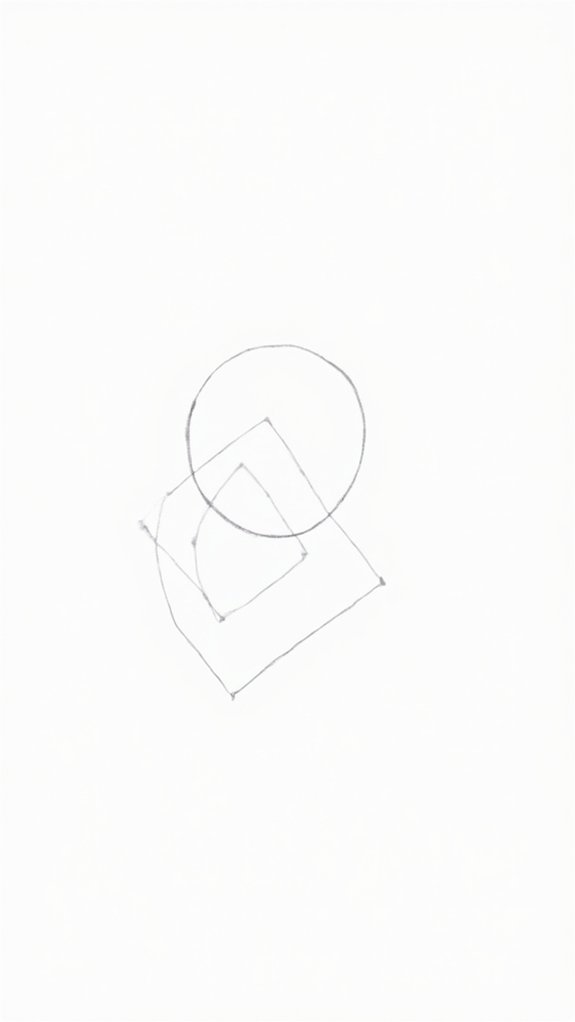
After wild spirals have had their turn on the page, it’s time for something a little more orderly—but just as eye-catching. Geometric shape outlines, like triangles, circles, and squares, can turn a blank space into a playground for minimalist doodle line art.
Artists can repeat these basic shapes, combining them in wild patterns or creating ultra-satisfying symmetry. It isn’t just about drawing perfect shapes, though! Playing with different line thicknesses adds a cool sense of depth—even a delicate square next to a chunky triangle catches your eye.
Masters of negative space know the secret: sometimes, leaving parts empty is what makes the whole thing pop! And let’s admit—using digital tools can make these geometric masterpieces even crisper (no eraser shavings required).
Wavy Line Compositions
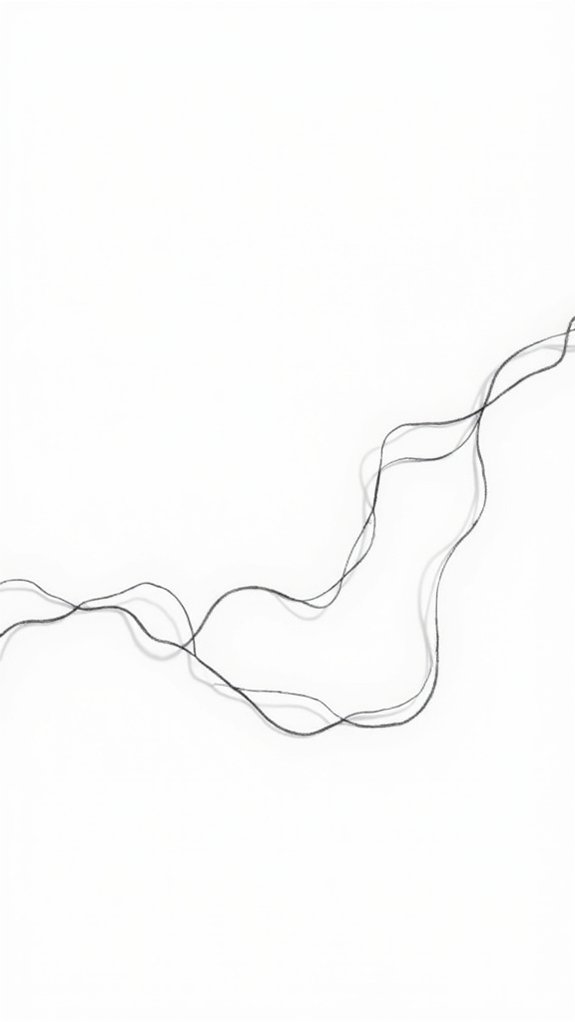
When straight lines start to feel a little too serious, wavy line compositions step in and change the whole vibe. Imagine lines that wander, curve, and dance across the page—suddenly, everything seems more relaxed and lively.
These wavy lines bring energy and rhythm, making each doodle feel like it’s in motion. By playing with line thickness, artists can create contrast and depth that really pop, even in a simple design.
Negative space works like magic here, letting the curves breathe and stand out. In AI Design, these flowing lines inspire fresh, stylish graphics for apps or posters.
Want to show calm or excitement? Shift the direction or speed of the waves! Minimalist doodle art just got a major upgrade.
Simple Plant and Leaf Motifs

Nature always seems to know how to keep things interesting—even with just a single leaf or a curling stem. When it comes to minimalist doodle line art, simple plant and leaf motifs absolutely shine.
Imagine a single, swooping line turning into a graceful fern, or a leaf drawn so simply it almost feels like magic. Artists often use negative space and repetitive patterns, making designs that feel calm but never boring.
If you browse any Stock Vector or Clip Art collection, you’ll probably spot these doodles everywhere—and there’s a reason for that! They fit in bullet journals, planners, and cool wall prints.
With different line weights and curvy touches, these motifs create tiny jungles you think you’ll love, without ever feeling messy.
Minimalist Faces in a Single Line
Minimalist faces in a single line are all about letting expressive curves and bold contours do the talking, with just one continuous line looping around to form noses, lips, or even wild expressions.
This style turns a simple squiggle into a whole new mood—sometimes it’s mysterious, sometimes it’s just plain goofy—and artists get to play with line thickness and unexpected twists.
It’s like drawing with no eraser and no turning back, where each stroke adds a dash of personality and surprise.
Expressive Curves and Contours
A single, swooping line can do something kind of magical: it can turn a blank page into a face full of feeling. With expressive curves and contours, artists can doodle minimalist faces that seem to laugh, pout, or glare—all with just one unbroken stroke.
This technique thrives on expressive line variations and emotional curve dynamics, leaving out what isn’t needed and focusing on contouring facial essence that gives each line its purpose. Here’s how these artistic choices make a face pop without a bunch of extra lines:
- Varying thickness adds drama to key features (hello, bold eyebrows!).
- Smooth curves capture gentle expressions or sly smirks.
- Snappy, angled sections bring energy or surprise.
- Distinct contours define noses and lips without overthinking it.
Continuous Line Techniques
Some artists treat their pens like tightrope walkers, balancing across the page without ever lifting off. Jumping into continuous line techniques, they focus on drawing minimalist faces in a single, unbroken stroke. It sounds tricky, but it’s all about line flow dynamics—following the way the pen swoops and curves, chasing the subject’s outline with confidence.
Minimalist expression techniques come into play when artists use just the right amount of line thickness or a simple curve to hint at a smile or a raised eyebrow. Continuous contour exploration lets them experiment, often creating faces that look simple but feel packed with personality. Even a shaky line adds character!
With practice, this style builds hand-eye coordination, making every doodler a little bit braver.
Abstract Emotional Expressions
When artists want to show big feelings with just a single, swooping line, things can get pretty exciting—almost like their pens are dancing to an invisible beat.
Abstract emotional expressions in minimalist faces hit differently because they use creative emotion exploration techniques. Think about it: with just one line, some artists manage to show everything from pure joy to deep sadness, no extra details needed!
The trick is all in those expressive line variations—thin curves, thick bends, wild zigzags. This is minimalism in art at its most fun and mysterious, inviting viewers to imagine the feelings behind every swirl and loop.
Here’s how it works:
- Exaggerated facial features for drama
- Continuous flowing lines
- Different line thicknesses
- Lots of space for imagination
Repetitive Pebble Circles
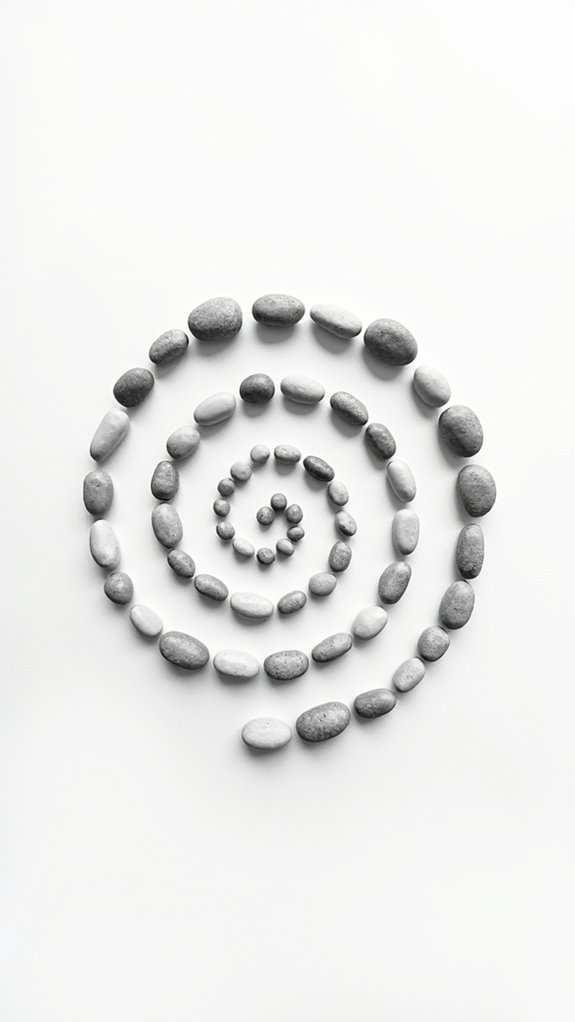
Pebble circles practically dance across the page, turning even the simplest doodle into something way more interesting.
With pebble circle variations—tiny pebbles clustered closely, giant ones spaced apart, or mid-sized ones overlapping—artists can create dynamic circle compositions that never get boring.
Want textures that pop? Try overlapping circle textures; stack those pebbles until the page feels almost bumpy!
Even beginners can master these rounded shapes, repeating them with ease and getting a sweet sense of satisfaction as their doodle fills out.
The best part: no two pebble circles have to look the same. Mix up the size, change the spacing, layer them until it’s like a minimalist rock garden.
Whether solo or paired with simple lines, these circles bring every drawing to life.
Abstract Ribbon Designs
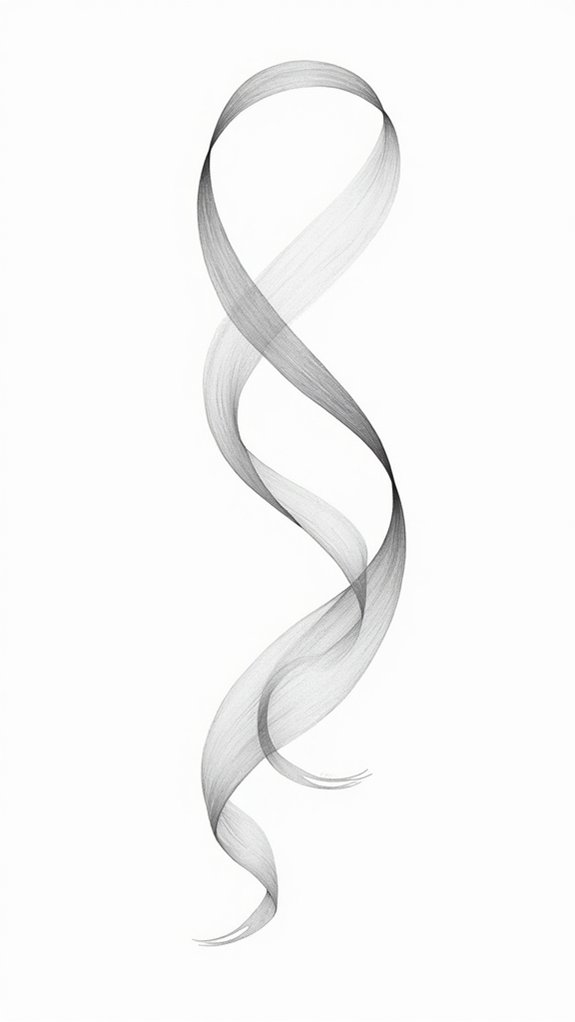
Flowing ribbons twist and swirl, turning simple lines into something that almost feels alive. With just a pen, artists can turn blank spaces into energetic shapes that pulse and dance across the page.
Abstract ribbon designs are all about those flowing contours and ribbon textures that seem to loop and slide together. Intertwined shapes—sometimes a little chaotic, sometimes gentle—give these doodles a real sense of movement. You can keep things classy with black and white or add a pop of color.
Here are four ways to create cool abstract ribbon doodles:
- Draw endless, looping curves that cross over themselves.
- Use varying line thickness for depth and drama.
- Experiment with negative space for extra impact.
- Combine tight twists and open swirls for excitement.
Airy Heart Nesting Doodles
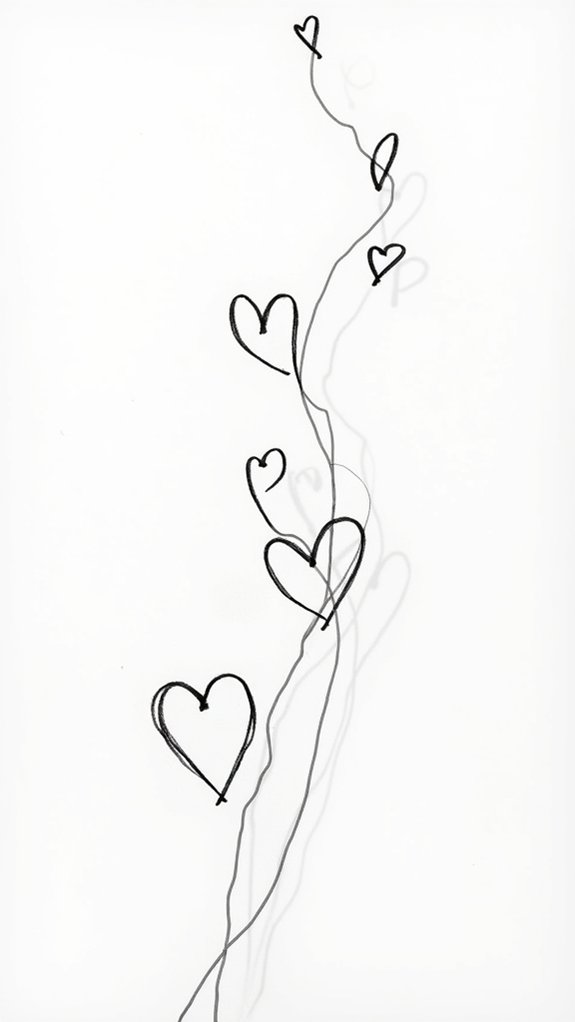
Some doodle ideas just have a way of stealing the show, and airy heart nesting doodles are definitely in that spotlight.
Imagine drawing a bunch of hearts inside each other, each one a different size—it’s like a little heart parade! This playful heart layering technique makes your page pop by building layers of cuteness and depth.
The real magic happens with negative space utilization. By leaving clear spaces between the hearts, the design breathes and doesn’t turn into a crowded heart party.
Want to spice things up even more? Sprinkle in some minimalist texture accents, like dots or tiny dashes. These simple details add interest while keeping your doodle looking clean. Perfect for greeting cards or any spot that needs a touch of charm!
Curly Tendril Borders
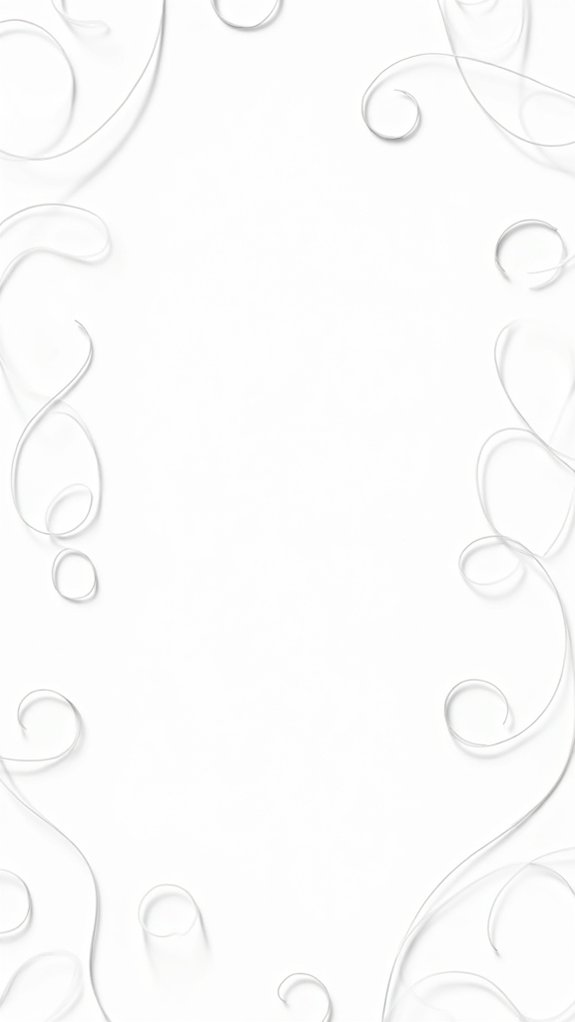
Curly tendril borders bring a whole lot of playful line movement to the edges of your doodles, twisting and looping like they’re dancing around your page.
With some clever line choices and a few changes in thickness, anyone can turn an ordinary border into something extra elegant, maybe even a little fancy.
These curly lines don’t just look cool—they add a pop of whimsical texture that makes the whole design feel more alive (kind of like your notebook just grew wild vines overnight).
Playful Line Movement
Although the name might sound like something out of a wizard’s garden, playful line movement with curly tendril borders is a seriously fun way to make minimalist doodle art pop.
These curly line variations do more than just sit there—they swirl, dance, and bounce around the page, bringing instant energy to otherwise simple designs. By layering playful border designs and letting those curly tendrils wiggle in unexpected ways, artists can pull your eyes exactly where they want them to go.
Plus, playing with whimsical movement effects creates a fresh, vibrant vibe. Here’s how to take those curly lines from “meh” to “wow”:
- Mix tight and loose curls for extra drama.
- Vary the thickness for visual punch.
- Twist tendrils in different directions.
- Leave negative space for a lively look.
Elegant Border Techniques
After all that wild, energetic line movement, it might sound impossible to make things look fancy without getting super complicated—but that’s where elegant border techniques totally shine.
Curly tendril borders keep things feeling light and elegant, but not boring. Just start with a simple line and let it twist into curly tendril variations, adding loops and playful curls. For extra style points, mix up the tendril thickness balance—go bold with some lines while letting others stay thin and wispy.
Don’t forget floral accent integration! Tiny leaves or mini flowers can pop up along those tendrils, making the border feel special but not too busy. Try nestling tendrils right at the edges, or make them swoop from corners for major visual movement and a touch of charm.
Adding Whimsical Texture
There’s just something magical about a border that swoops and spirals like it’s alive, and that’s exactly what happens when artists add in those twisty, vine-inspired lines known as curly tendrils.
These dreamy tendril variations can turn any plain doodle into a fun, energetic masterpiece—talk about giving your art a wild hair day! By playing with different thicknesses and curvy shapes, plenty of depth creeps in, making the whole thing pop.
If you want to level up the whimsy, toss some dots or teeny leaves onto the ends. Suddenly, you’ve got a framing that feels totally enchanted and perfectly minimalist.
For maximum impact, try these curly border ideas:
- Loopy, floating curls
- Tight spiral tendrils
- Alternating thick and thin lines
- Dots or leafy endpoints
Cascading Teardrop Lines
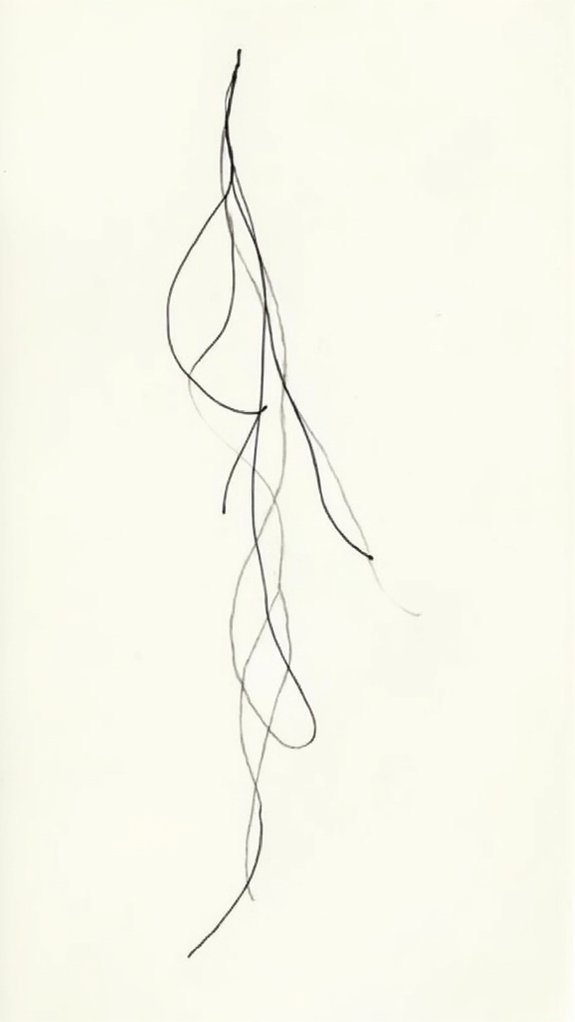
Cascading teardrop lines are like an artsy waterfall—smooth, flowing, and super satisfying to draw. Imagine each teardrop lined up in a row, but instead of staying the same, they change a little every time—hello, teardrop variations!
Some droop close together, some stretch out with more space, and suddenly, there’s a cool cascading rhythm, almost like a gentle musical beat in the drawing.
Try making each teardrop bigger or smaller as they go down, or play with line thickness so the lines look bolder or softer in different spots. Curves can help everything feel nice and smooth.
Altogether, cascading teardrop lines turn a plain piece of paper into something peaceful and pretty, with just a few simple tricks.
Ribbon-Wrapped Frames
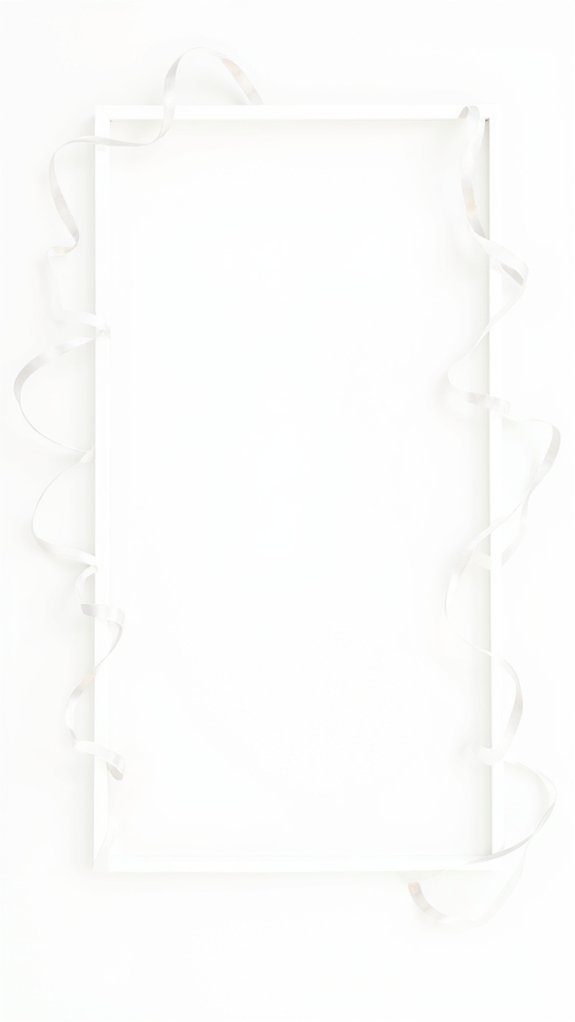
Ribbon-wrapped frames are a cool way to bring fancy borders into minimalist doodle line art, using simple ribbon drawing techniques that twist and loop around the edges.
With smooth, flowing lines, these frames can really make any message or picture stand out, and you can even play with tiny bows or curly ends for that extra bit of charm—kind of like dressing up your artwork for a special occasion.
It’s easy to try, fun to customize, and honestly, who knew a ribbon could look so classy just squiggling around a page?
Simple Ribbon Drawing Techniques
Dive right in and imagine a simple frame just waiting to get dressed up—nothing adds more charm than a lively ribbon twisting around its border.
Creating minimalist ribbon-wrapped frames is like giving your artwork a bowtie—suddenly, everything feels festive! To kickstart your design, think ribbon folding techniques: pretend you’re wrapping a present and let the ribbon swirl, bend, and loop with ease.
Play with color gradient applications for a soft shimmer, then spice up your frame by trying out different decorative knot styles.
Want to take it a step further? Outline your ideas with a plan like this:
- Sketch a plain rectangular frame.
- Loop ribbon shapes around, folding and curving them.
- Vary line thickness for depth.
- Add shadow, knots, and creative embellishments.
Framing With Flowing Lines
While some frames just sit there looking plain and serious, framing with flowing lines turns every border into a mini celebration. Instead of stiff corners, these minimalist frame designs wrap around like playful ribbons, adding energy and elegance in one swoop.
Artists love to play with line thickness variations—some parts are bold and full of personality, while others just quietly whisper on the paper. That back-and-forth keeps your eyes interested but never feels chaotic.
Sometimes, a smart twist of the line creates a loop or a gentle curl, making the frame look like it’s practically dancing. Best of all, negative space exploration lets the empty areas shine, highlighting what’s inside the frame.
Minimalist? Absolutely. Boring? Never. It’s sophisticated fun on every border.
Adding Delicate Decorative Touches
Let’s shake things up—adding delicate decorative touches is where minimalist doodle line art really starts to sparkle, especially when frames look like they’re wrapped in ribbon.
Instead of plain boxes, imagine your art framed by flowing ribbons that bring in subtle accents and a bit of personality. These delicate embellishments can turn a simple drawing into something with a burst of elegance—without being too flashy!
By playing with line thickness and adding intricate details like tiny knots, even the simplest doodles get a super cool upgrade.
Here’s how to add those ribbon-wrapped frame vibes:
- Begin with a wavy line to mimic ribbon’s flowing fabric.
- Vary line thickness for depth and movement.
- Draw knots or bows at corners as subtle accents.
- Experiment with loops, curls, or different ribbon shapes.
Elegant Laurel and Wreath Sketches
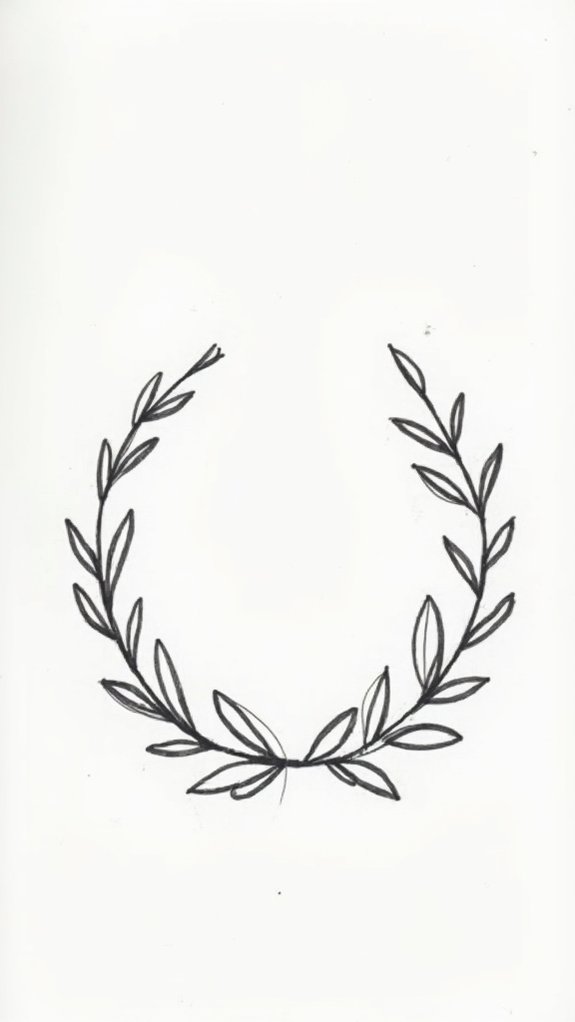
Even the simplest laurel or wreath doodle can totally steal the show, wrapping up a page with the kind of fancy vibes that usually only show up at royal ceremonies—or, you know, in the winner’s circle. Laurel symbolism meanings lean hard into victory, honor, and achievement, so if you need your notebook to say, “I’m basically legendary,” this is a solid move. There are tons of wreath design variations: single-branch minimal, full-circle grand, or even a quirky asymmetric twist for a modern spin. Minimalist composition tips? Stick to clean, flowing lines, lots of negative space, and keep those leaves balanced. Want more inspiration? Here’s a cheat sheet:
| Symbolism | Design Variations | Minimalist Tips |
|---|---|---|
| Victory | Full circle | Use symmetry |
| Honor | Half-wreath | Balance spacing |
| Achievement | Asymmetric branches | Limit line weight |
Frequently Asked Questions
What Is Minimalist Line Art?
Minimalist line art is an artistic style characterized by simple shapes and abstract forms, utilizing clean, minimal lines. This approach emphasizes negative space and fosters creative expressions, conveying ideas or emotions with clarity and visual simplicity.
What Are the Five Styles of Doodling?
The current question explores five styles of doodling, including abstract doodle styles, playful doodle techniques, geometric doodle patterns, Zentangle, and line art. Each style offers unique approaches, ranging from structured patterns to expressive, whimsical compositions.
How Do You Make a Doodle Line?
To make a doodle line, one applies doodle techniques by starting with basic shapes, varying line thickness for depth, and drawing smoothly. Creative inspiration guides the addition of patterns or curves, producing engaging, visually interesting compositions.
What Does Doodling Straight Lines Mean?
Doodling straight lines, from a Doodle psychology perspective, often reflects a desire for order or clarity. Line interpretations suggest structure and control, while the act itself can facilitate creative expression and serve as a mindful, focused practice.
Conclusion
All in all, minimalist doodle line art proves you don’t need a million colors or wild details to create something eye-catching. Whether it’s a wavy line, a single looping face, or a twirly plant, simple shapes pack a punch. Anyone can try these ideas—no fancy supplies or hours of practice required. If your lines get a little wobbly, hey, that just adds character! So, grab a pen and let your imagination wiggle free.


Leave a Reply